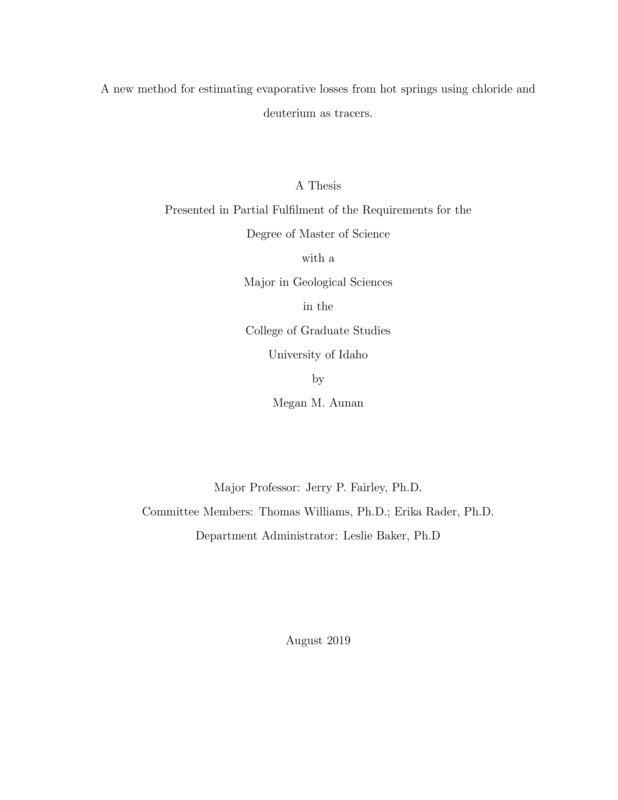A new method for estimating evaporative losses from hot springs using chloride and deuterium as tracers.
AUNAN, MEGAN M. (2019-08). A new method for estimating evaporative losses from hot springs using chloride and deuterium as tracers.. Theses and Dissertations Collection, University of Idaho Library Digital Collections. https://www.lib.uidaho.edu/digital/etd/items/aunan_idaho_0089n_11681.html
- Title:
- A new method for estimating evaporative losses from hot springs using chloride and deuterium as tracers.
- Author:
- AUNAN, MEGAN M
- Date:
- 2019-08
- Program:
- Geology
- Subject Category:
- Geology; Hydrologic sciences
- Abstract:
-
Estimates of the total heat budget of a thermal area is typically derived using the basic principles of mass and energy balance but the parameters neccessary to make such estimates are expensive and difficult to measure. Commonly, investigators use chemical tracers as proxies for parameters allowing the mass transfer by advective transport (flowing water) to be estimated. In spite of the available methodology for predicting advective fluxes, the heat transferred by vapor during evaporation has not yet been calculated. Evaporative processes are generally elevated in thermal areas due to large temperature gradients between surface water and the atmosphere, as well as convective transport at the spring surface by wind. The effect of evaporation on mass transfer is likely negligible but its effect on energy transfer is likely much greater and, therefore, requires further investigation. Expanding on published tracer techniques, I introduce a new method to quantify evaporation losses by intiating an instantaneous increase of two chemical tracers in two hot springs in The Borax Lake Thermal Area, one tracer is a conservative species that does not leave the liquid water to partition with vapor during evaporation (chloride) and the other is non-conservative and will partition with vapor to leave the liquid water (deuterium). By contrasting each tracers return to normal background levels, the model can predict the rates at which water is entering the spring in the subsurface, liquid water is leaving the spring, and water vapor is lost by evaporation. In addition, the model calculates the volume involved with subsurface mixing and estimates the concentration of chloride and the $\delta D$-values of the incoming liquid and the vapor leaving the springs. An extension of the model calculates an energy balance and indicates that the effect of evaporation on energy transfer due to the latent heat of evaportation can account for 16-20 \%\ of the advective heat transported by the liquid water. This method provides an easy, inexpensive technique to quantify the energy loss by evaporation in a thermal area.
- Description:
- masters, M.S., Geology -- University of Idaho - College of Graduate Studies, 2019-08
- Major Professor:
- Fairley, Jerry P
- Committee:
- Williams, Thomas; Rader, Erika
- Defense Date:
- 2019-08
- Identifier:
- AUNAN_idaho_0089N_11681
- Type:
- Text
- Format Original:
- Format:
- application/pdf
- Rights:
- In Copyright - Educational Use Permitted. For more information, please contact University of Idaho Library Special Collections and Archives Department at libspec@uidaho.edu.
- Standardized Rights:
- http://rightsstatements.org/vocab/InC-EDU/1.0/

